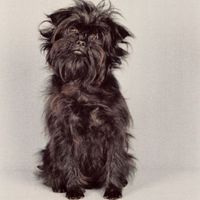
German Pinscher / Deutscher Pinscher

Breed history:
It is an old German breed which contributed to the development of some well-known dog breeds, such as the Doberman or Schnauzer. It was one of the first German dogs that participated in a dog show. It was acknowledged as a breed in 1879. It is widely spread and appreciated in many countries especially in Germany and France.
Description:
It is a medium-sized dog, with a square look, harmonious shapes, sturdy, yet elegant. It has a trapezoidal, long head, with a long muzzle and a blunt nose. The ears are drooping at birth, but are usually cropped to stay erect. The tail is usually docked. The coat has short, dense, soft, smooth and glossy hair. It can be solid colour (reddish-brown) or bicoloured (brick-black or coffee-coloured or blue with red spots).
Personality:
It is a dog with a great capacity to adapt, it is intelligent, lively, playful, alert and very faithful to its master. Affectionate and devoted to the family, it is patient and playful with children. It barks at strangers at first, but it settles down quickly. It gets along well with other animals and other dogs.
Grooming:
A casual brushing and a more frequent one during the shedding period is enough.
Living conditions:
It prefers outdoor life but it can easily adapt to an apartment if it gets daily exercise. It needs socialization, training and exercise.
Training:
It is an easy dog to train that enjoys learning. The training must be gentle, but firm and consistent. It likes canine sports.
Usefulness:
Used in the past to catch rodents (mice, rats), today it is used especially as a watchdog and as a companion dog.


Austrian Shorthaired Pinscher
Austrian Pinscher, Osterreichischer Kurzhaarpinscher, Österreichischer, Österreichischer Pinscher





